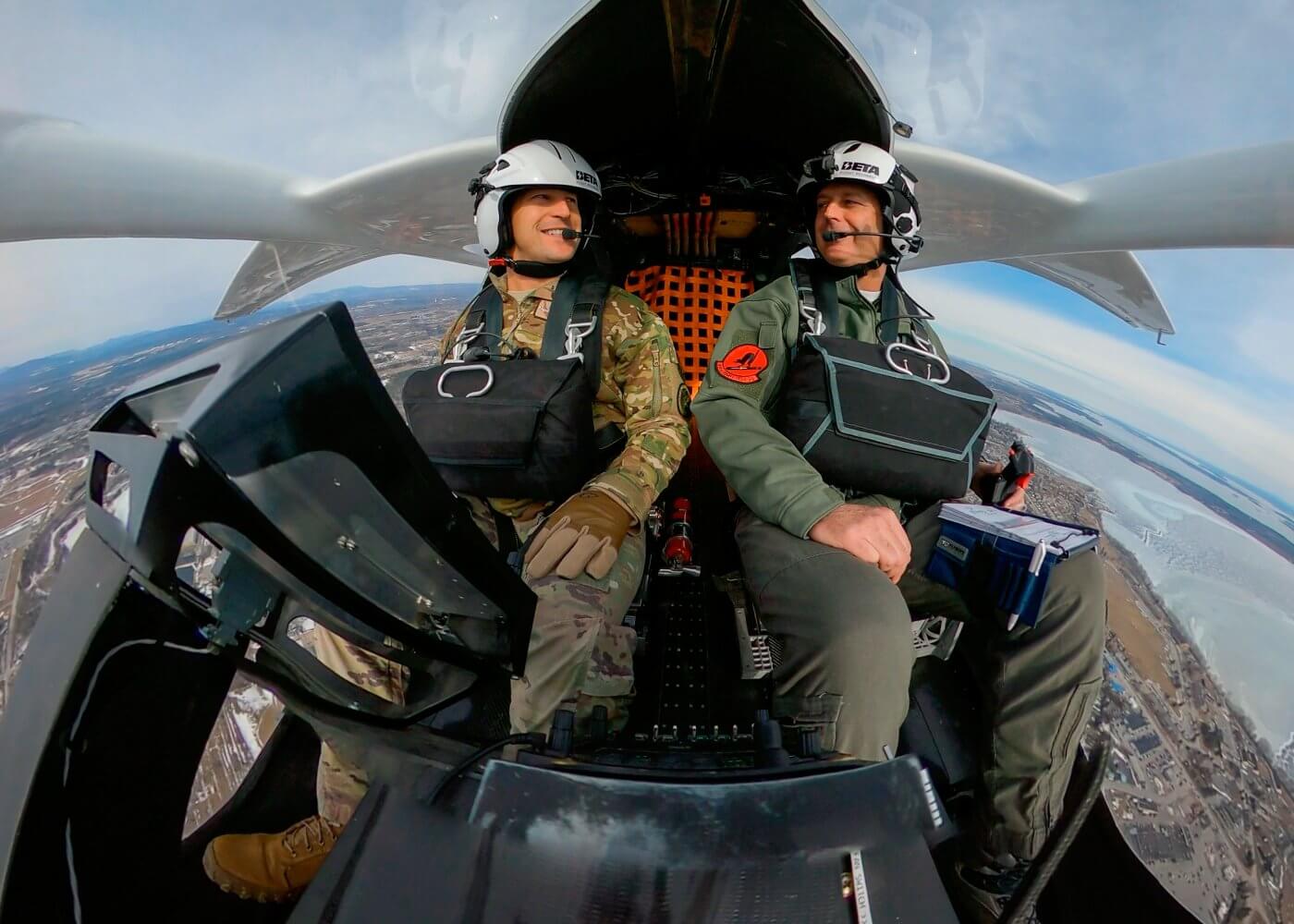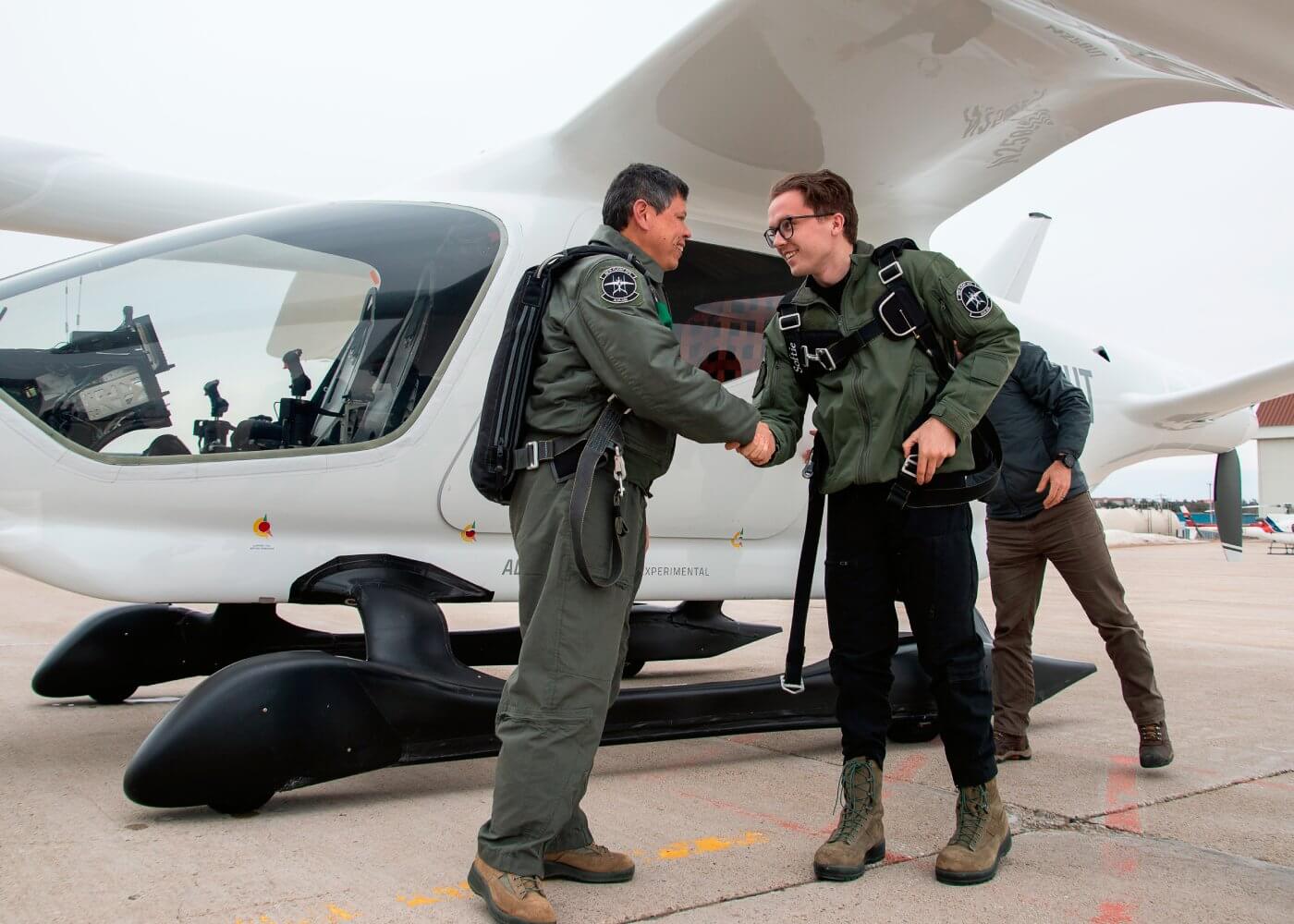Not long after the U.S. Air Force (USAF) announced its goal of achieving the first crewed flight of an eVTOL aircraft last month did the USAF achieve its mission. The milestone flight happened last week using Beta Technologies’ Alia electric aircraft.

The Vermont-based eVTOL company said the flight demonstration was conducted on March 9 by USAF pilots Hank “Hog” Griffiths and Major Jonathan Appleby, marking a significant milestone for not only the USAF but also Beta’s work in the Agility Prime program since receiving the first airworthiness approval for a manned electric aircraft in 2021.
“It was a blessing and honor to conduct the first flight for the USAF in the Alia-250 which was designed, built, and maintained by the dedicated professionals of Beta,” Appleby said. “I am excited to watch Beta continue to develop their revolutionary aircraft for civil and military use cases and grateful for the opportunity to experience electric flight.”
The milestone flight took place at Beta’s testing facility in Plattsburgh, New York, where the pilots flew the Alia aircraft over Lake Champlain to Beta’s headquarters in Burlington, Vermont.
Appleby piloted the aircraft that morning with Beta test pilot Camron Guthrie, followed by Griffiths that afternoon with test pilot Lochie Ferrier. And just as Beta’s previous flights were conducted in airplane mode, with its overhead lifting propellers removed, the USAF flights were also conducted in CTOL mode.
Before getting behind the controls of the Alia aircraft, both Griffiths and Appleby underwent extensive training. This started with reviewing the comprehensive Alia manuals and additional materials compiled by Beta engineers who built the Alia, before even arriving in Burlington, Vermont.
Once the two landed at Beta headquarters, they spent two days training on site, starting with ground school that included individual sessions covering every aspect of the Alia — its structures, batteries, electric engines, flight controls, aerodynamics, and avionics — as well as preflight safety training.

Following the ground school, Griffiths and Appleby began simulator training, where each pilot was able to fly the exact test flight route in Beta’s thunderdome simulator — built in-house and used for training, data-gathering, and route mapping.
The training was comprehensive, but not surprising for the eVTOL developer. Beta is known for providing flight training to its own employees, as well as offering its partner and CEO of United Therapeutics Martine Rothblatt a chance to get behind the controls of the Alia.
“For over two years, we’ve worked hand-in-hand with the Air Force Agility Prime team to refine our electric aircraft, and we’ve made great progress together,” said Kyle Clark, Beta’s founder and CEO. The partnership is currently operating under a Phase II Small Business Innovation Research (SBIR) contract.
“It’s an honor to have Griffiths and Appleby fly our aircraft, and we’re humbled by the Air Force’s continued support and confidence in our engineering,” Clark continued. “This flight signifies an important milestone, providing the opportunity for a clean future for our nation’s military and a path to fossil fuel independence.”
Griffiths, who is the AFWERX airworthiness and test lead, said the USAF’s qualitative evaluation flight will be the first of many that it plans to conduct with Beta and its other Agility Prime partners.
“In addition to accelerating these company’s path to FAA [Federal Aviation Administration] type certification by providing access to USAF engineering expertise and test infrastructure, we are also evaluating these prototypes for opportunities to utilize them for unique military missions,” Griffiths said. “We need government pilots to accomplish those evaluations, and this is the first step in developing the training and experimentation plans to do so.”
While the Alia aircraft, which has been in development for three years, was created to be a cargo carrier that can fit a pilot and three standard pallets, the company said it can also seat a pilot and up to five passengers.
With a wingspan of 50 feet (15 meters) and recharge time of under an hour, the Alia aircraft is targeting a range of 250 nautical miles (288 miles or 463 kilometers) and a top speed of about 150 knots (173 miles per hour or 278 kilometers per hour).
Along with the aircraft, the company is also introducing a charging infrastructure, with more than 60 charging stations online or in development so far from Vermont to Arkansas.
“Beta has developed a unique eVTOL air system that is the complete package and includes an air vehicle and charging network that will surely compete well in this emerging competitive market,” Griffiths said.
This article has been updated to clarify that the U.S. Air Force flights took place in conventional take-off and landing mode, with the aircraft’s overhead lifting propellers removed.





when will this eVTOL be available for sale to General Aviation?
Very good results from the
program thus far. Imagine what this platform will be like in 20 years from now. Fly the Blue!
They did not fly an eVTOL aircraft. This video shows them flying an aircraft that may eventually become an eVTOL aircraft, but in it’s current configuration, it had to have done a conventional takeoff and landing. The lift motors and props were not installed.
Good eye.
I don’t know why your Anonymous. You the only one to catch that.
Your the observant individual must places want to hire.
They are working on getting their fixed wing flight certification and then attach the lift rotors as they progress to VTOL certification.
Kudos to the technologists behind this development …
What is the size of the battery on-board for this performance ? … in kW-h (or MW-h) ?
I would love to hear the flight crews feeling for would they fly this aircraft over a contested environment.
Second question is given the frst what missions do they see the platform suited for ?
taking off on those tiny wheels and rotating for lift off would have been interesting (look how far aft the rear wheels are ) the lifting props for this aircraft look weird in terms of blade shape (like ellipsis ) hard to see how there is enough blade area .
I am a helocopter pilot and have 20 years as an industrial director in the field of energy and energy efficiency.
What do I have to do to become a pilot of an evtol?
Congratulations!